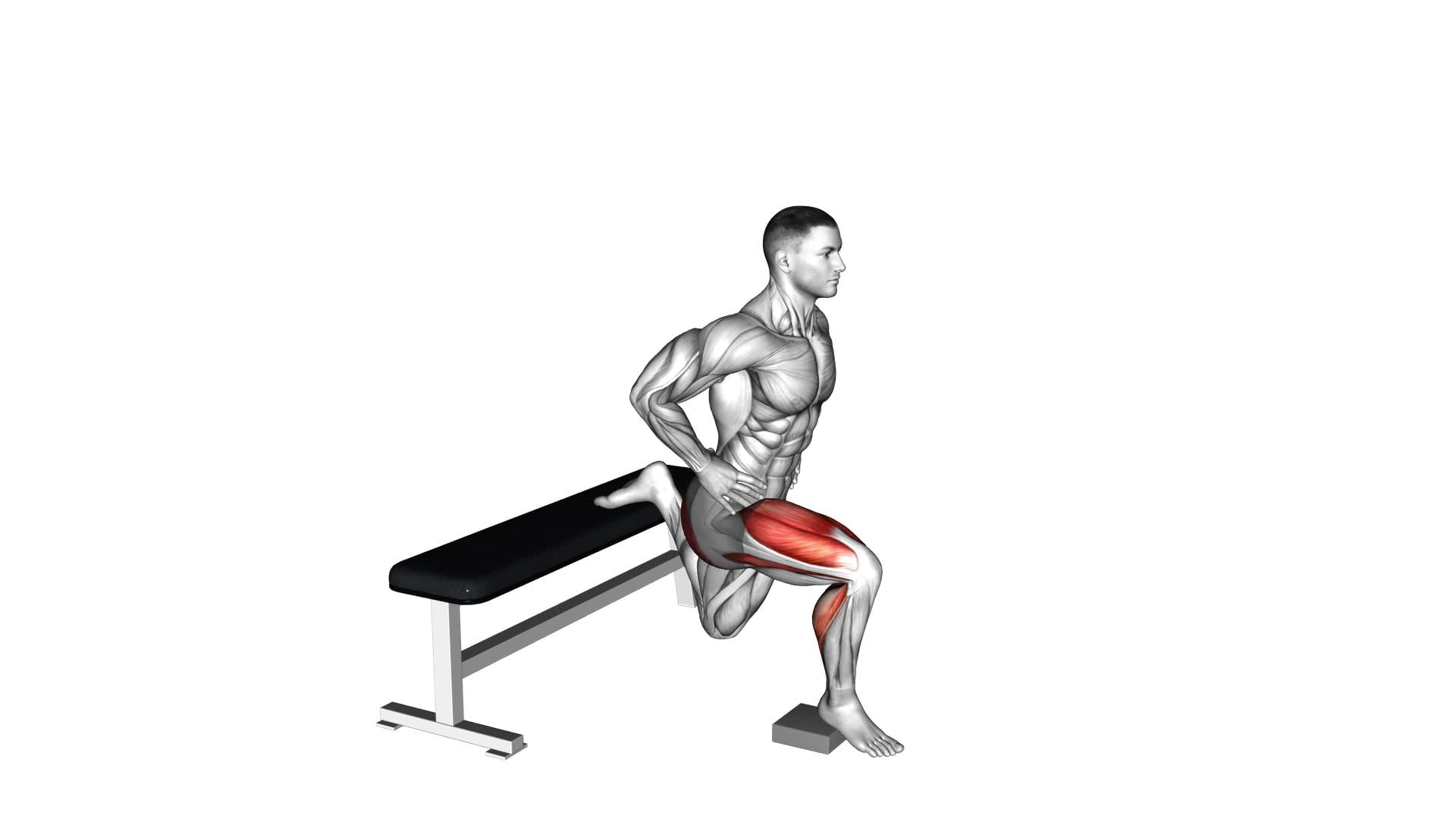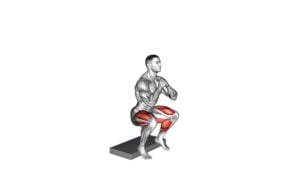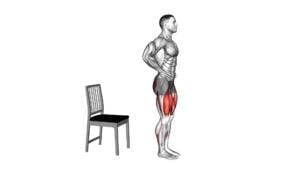Bodyweight Heel Elevated Bulgarian Split Squat (male) – Video Exercise Guide & Tips

Get ready to take your leg workout to the next level with the bodyweight heel elevated Bulgarian split squat. This exercise targets your quads, glutes, and hamstrings, helping you build strength and definition.
Watch This Exercise Video
In this video exercise guide, you'll learn the proper form and technique for performing this challenging move. Whether you're a beginner or advanced, our tips and variations will help you maximize your results.
So grab a mat and get ready to feel the burn!
Key Takeaways
- Targets multiple muscle groups simultaneously
- Strengthens and stabilizes the lower body
- Activates core muscles for improved stability and balance
- Increases glute muscle strength and definition
Benefits of the Bulgarian Split Squat
To maximize the effectiveness of your workouts, one benefit of the Bulgarian Split Squat is that it targets multiple muscle groups simultaneously. This exercise is a great choice for injury prevention and muscle activation. By engaging muscles in the lower body, such as the quadriceps, hamstrings, glutes, and calves, the Bulgarian Split Squat helps to strengthen and stabilize these areas, reducing the risk of injuries. Additionally, the exercise activates the core muscles, helping to improve overall stability and balance.
The Bulgarian Split Squat is particularly effective for activating the glute muscles. By placing one foot behind you on an elevated surface, such as a bench or step, and lowering your body into a lunge position, you're able to isolate and target the glutes, making them work harder. This can lead to increased muscle strength and definition in the gluteal region.
Incorporating the Bulgarian Split Squat into your workout routine can help you achieve a well-rounded lower body workout, while also preventing injuries and promoting muscle activation. Now that you understand the benefits of this exercise, it's important to focus on proper form and technique to ensure maximum effectiveness and safety.
Proper Form and Technique
For proper form and technique in the Bodyweight Heel Elevated Bulgarian Split Squat, position your front foot forward and your back foot elevated on a bench or step. This exercise targets your quadriceps, hamstrings, and glutes, while also improving balance and stability. To perform the exercise correctly, keep your chest up, shoulders back, and gaze forward throughout the movement.
As you lower your body, ensure that your front knee is directly over your ankle, and your back knee is lowered towards the ground without touching it. Avoid leaning forward or rounding your back, as this can place unnecessary strain on your knees and lower back.
Common errors to watch out for include allowing your front knee to track too far forward, which can increase the risk of knee pain and injury. Another mistake is lifting your back heel off the elevated surface, which reduces stability and decreases the effectiveness of the exercise. To prevent these errors, focus on maintaining proper alignment and engaging your core muscles for stability.
For beginners or those with limited mobility, modifications can be made to make the exercise more accessible. Start by using a lower elevation for your back foot, such as a small step or block. You can also reduce the range of motion by not going as low into the squat position. Gradually increase the difficulty by elevating your back foot higher or using weights as you become more comfortable and stronger.
Variation for Advanced Training
To further challenge your muscles and elevate your training, try incorporating the Bodyweight Heel Elevated Bulgarian Split Squat with added resistance or instability.
Advanced modifications of this exercise can be done by using equipment options such as dumbbells, kettlebells, or resistance bands.
One way to add resistance to the Bodyweight Heel Elevated Bulgarian Split Squat is by holding dumbbells in each hand. Start by standing with your back foot elevated on a bench or step and your front foot positioned a few feet in front of it. Hold the dumbbells at your sides with your palms facing your body. As you lower into the squat, keep your chest up and your back straight. Push through your front heel to return to the starting position. The added weight from the dumbbells will make this exercise more challenging and help to further strengthen your legs and glutes.
Another option is to use a kettlebell. Hold the kettlebell in front of your chest with both hands, keeping your elbows tucked in. As you perform the squat, keep your core engaged and your back straight. The kettlebell will add resistance to your lower body, making the exercise more intense.
For added instability, you can use a resistance band. Place the band around your front foot and hold the ends of the band in each hand. As you perform the squat, the tension from the band will challenge your balance and stability, engaging your core and smaller stabilizer muscles.
Incorporating these advanced modifications with added resistance or instability will take your Bodyweight Heel Elevated Bulgarian Split Squat to the next level, helping you to build strength, improve balance, and enhance overall athletic performance.
Common Mistakes to Avoid
You should avoid making these common mistakes when performing the Bodyweight Heel Elevated Bulgarian Split Squat. Proper form is crucial to maximize the effectiveness of this exercise and prevent injury.
One common mistake is allowing the front knee to go past the toes. This puts excessive stress on the knee joint and can lead to pain or injury. To avoid this, focus on keeping your weight on your back leg and keeping the front knee in line with your ankle.
Another mistake isn't maintaining proper alignment of the torso. It's important to keep your chest up and your back straight throughout the movement. Avoid leaning forward or rounding your shoulders, as this can lead to strain in the lower back.
Lastly, make sure to engage your core muscles throughout the exercise. Neglecting to do so can result in instability and decreased effectiveness.
Tips for Maximizing Results
How can you effectively maximize your results when performing the Bodyweight Heel Elevated Bulgarian Split Squat? Here are some tips for beginners looking to incorporate Bulgarian split squats into their workout routine.
- Start with proper form: Before adding weight or intensity, make sure you have mastered the basic technique. Keep your front foot planted firmly on the ground, with your knee tracking over your toes. Your back foot should be elevated on a stable surface, like a bench or step.
- Gradually increase intensity: As a beginner, start with bodyweight only and focus on getting comfortable with the movement. Once you feel confident, you can add resistance by holding dumbbells or using a barbell across your upper back.
- Pay attention to balance: Bulgarian split squats challenge your balance, so it's important to take it slow and focus on stability. You can use your arms for balance by keeping them extended in front of you or holding onto a wall or support if needed.
- Vary your foot placement: Experiment with different foot positions to target different muscles. Placing your front foot farther forward will emphasize the quadriceps, while moving it closer to your body will activate the glutes and hamstrings more.
- Include them in your leg day routine: Bulgarian split squats are an excellent exercise for building lower body strength and stability. Consider adding them to your leg day routine alongside other compound exercises like squats and lunges.
Frequently Asked Questions
How Many Calories Does the Bodyweight Heel Elevated Bulgarian Split Squat Burn?
The Bodyweight Heel Elevated Bulgarian Split Squat is an effective exercise for burning calories. When performed correctly, this exercise can help you burn a significant amount of calories.
It's especially beneficial for beginners who are looking to increase their calorie burn and build strength. By incorporating this exercise into your workout routine, you can achieve your fitness goals and improve your overall health.
Can the Bodyweight Heel Elevated Bulgarian Split Squat Help Improve Balance and Stability?
The bodyweight heel elevated Bulgarian split squat can greatly improve your balance and stability. By targeting your lower body muscles, this exercise helps to strengthen your leg muscles and stabilize your core.
It's an effective way to enhance your overall functional fitness and prevent injuries. Additionally, this exercise can be modified and adjusted to different fitness levels, making it suitable for beginners and advanced individuals alike.
Incorporating this exercise into your workout routine can lead to significant improvements in your balance and stability.
Is the Bodyweight Heel Elevated Bulgarian Split Squat Suitable for Beginners?
The bodyweight heel elevated Bulgarian split squat can be a suitable exercise for beginners looking to improve their lower body strength and stability.
However, if you find this exercise too challenging, there are alternative exercises that you can try.
For example, you can start with regular split squats or lunges before progressing to the heel elevated version.
Additionally, you can modify the exercise by using a lower elevation or holding onto a stable object for support.
How Often Should the Bodyweight Heel Elevated Bulgarian Split Squat Be Performed for Optimal Results?
To achieve optimal results with the bodyweight heel elevated Bulgarian split squat, it's important to consider the frequency of performing this exercise. The frequency will vary depending on your specific goals and fitness level.
It's generally recommended to include this exercise in your routine 2-3 times per week for muscle growth. However, it's always important to listen to your body and avoid overtraining.
Incorporating this exercise into a full body workout routine can help with overall strength development.
Can the Bodyweight Heel Elevated Bulgarian Split Squat Help With Strengthening the Core Muscles?
To answer your question, yes, the bodyweight heel elevated Bulgarian split squat can definitely help in strengthening your core muscles.
This exercise targets multiple muscle groups, including the glutes, hamstrings, quadriceps, and core.
By performing this exercise regularly, you can improve your core stability and overall balance.
Additionally, bodyweight exercises like this have the added benefit of not requiring any equipment, making them convenient and accessible for anyone looking to strengthen their core.
Conclusion
In conclusion, the Bulgarian split squat is a highly beneficial exercise for building lower body strength and stability.
By elevating the heel and maintaining proper form, you can target the glutes, quads, and hamstrings effectively.
Adding variations and avoiding common mistakes will help you advance in your training.
Remember to stay consistent and follow the tips provided to maximize your results.

Author
Years ago, the spark of my life’s passion ignited in my mind the moment I stepped into the local gym for the first time. The inaugural bead of perspiration, the initial endeavor, the very first surge of endorphins, and a sense of pride that washed over me post-workout marked the beginning of my deep-seated interest in strength sports, fitness, and sports nutrition. This very curiosity blossomed rapidly into a profound fascination, propelling me to earn a Master’s degree in Physical Education from the Academy of Physical Education in Krakow, followed by a Sports Manager diploma from the Jagiellonian University. My journey of growth led me to gain more specialized qualifications, such as being a certified personal trainer with a focus on sports dietetics, a lifeguard, and an instructor for wellness and corrective gymnastics. Theoretical knowledge paired seamlessly with practical experience, reinforcing my belief that the transformation of individuals under my guidance was also a reflection of my personal growth. This belief holds true even today. Each day, I strive to push the boundaries and explore new realms. These realms gently elevate me to greater heights. The unique combination of passion for my field and the continuous quest for growth fuels my drive to break new ground.







